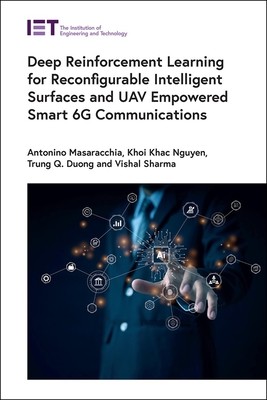
- We will send in 10–14 business days.
- Author: Antonino Masaracchia
- Publisher: Institution of Engineering & Technology
- ISBN-10: 1839536411
- ISBN-13: 9781839536410
- Format: 15.6 x 23.4 x 1.8 cm, kieti viršeliai
- Language: English
- SAVE -10% with code: EXTRA
Deep Reinforcement Learning for Reconfigurable Intelligent Surfaces and Uav Empowered Smart 6g Communications (e-book) (used book) | bookbook.eu
Reviews
Description
Reconfigurable intelligent surface (RIS) has emerged as a cutting-edge technology for beyond 5G and 6G networks due to its low-cost hardware production, nearly passive nature, easy deployment, communication without new waves, and energy-saving benefits. Unmanned aerial vehicle (UAV)-assisted wireless networks significantly enhance network coverage.
Resource allocation and real-time decision-making optimisation play a pivotal role in approaching the optimal performance in UAV- and RIS-aided wireless communications. But the existing contributions typically assume having a static environment and often ignore the stringent flight time constraints in real-life applications. It is crucial to improve the decision-making time for meeting the stringent requirements of UAV-assisted wireless networks. Deep reinforcement learning (DRL), which is a combination of reinforcement learning and neural networks, is used to maximise network performance, reduce power consumption, and improve the processing time for real-time. DRL algorithms can help UAVs and RIS work fully autonomously, reduce energy consumption and operate optimally in an unexpected environment.
This co-authored book explores the many challenges arising from real-time and autonomous decision-making for 6G. The goal is to provide readers with comprehensive insights into the models and techniques of deep reinforcement learning and its applications in 6G networks and Internet-of-Things with the support of UAVs and RIS.
Deep Reinforcement Learning for Reconfigurable Intelligent Surfaces and UAV Empowered Smart 6G Communications is aimed at a wide audience of researchers, practitioners, scientists, professors and advanced students in engineering, computer science, information technology, and communication engineering, and networking and ubiquitous computing professionals.
EXTRA 10 % discount with code: EXTRA
The promotion ends in 22d.15:56:51
The discount code is valid when purchasing from 10 €. Discounts do not stack.
- Author: Antonino Masaracchia
- Publisher: Institution of Engineering & Technology
- ISBN-10: 1839536411
- ISBN-13: 9781839536410
- Format: 15.6 x 23.4 x 1.8 cm, kieti viršeliai
- Language: English English
Reconfigurable intelligent surface (RIS) has emerged as a cutting-edge technology for beyond 5G and 6G networks due to its low-cost hardware production, nearly passive nature, easy deployment, communication without new waves, and energy-saving benefits. Unmanned aerial vehicle (UAV)-assisted wireless networks significantly enhance network coverage.
Resource allocation and real-time decision-making optimisation play a pivotal role in approaching the optimal performance in UAV- and RIS-aided wireless communications. But the existing contributions typically assume having a static environment and often ignore the stringent flight time constraints in real-life applications. It is crucial to improve the decision-making time for meeting the stringent requirements of UAV-assisted wireless networks. Deep reinforcement learning (DRL), which is a combination of reinforcement learning and neural networks, is used to maximise network performance, reduce power consumption, and improve the processing time for real-time. DRL algorithms can help UAVs and RIS work fully autonomously, reduce energy consumption and operate optimally in an unexpected environment.
This co-authored book explores the many challenges arising from real-time and autonomous decision-making for 6G. The goal is to provide readers with comprehensive insights into the models and techniques of deep reinforcement learning and its applications in 6G networks and Internet-of-Things with the support of UAVs and RIS.
Deep Reinforcement Learning for Reconfigurable Intelligent Surfaces and UAV Empowered Smart 6G Communications is aimed at a wide audience of researchers, practitioners, scientists, professors and advanced students in engineering, computer science, information technology, and communication engineering, and networking and ubiquitous computing professionals.


Reviews